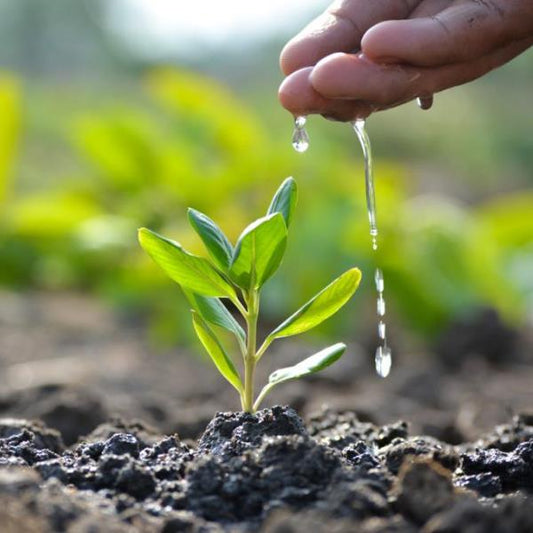

In the global fight against climate change, India is taking a significant step forward with the launch of the Green Credit Programme (GCP) in October 2023. This innovative market-based mechanism aims to incentivize environmentally conscious practices and create a greener future for the nation. This Read more
Trending
Trees for Corporates
Green Gold
In the global fight against climate change, India is taking a significant step forward with the launch of the Green Credit Programme (GCP) in October 2023. This innovative market-based mechanism aims to incentivize environmentally conscious practices and create a greener future for the nation.
This blog delves deeper into the Green Credit Programme, exploring its objectives, functionalities, and potential impact. We'll also analyze the current stage of development and future prospects, providing you with a comprehensive understanding of this groundbreaking initiative.
A Market for Environmental Benefits
The core concept of the GCP lies in creating a market for environmental benefits. Individuals, industries, and organizations can earn tradable "Green Credits" by undertaking activities that demonstrably benefit the environment. These activities can include:
- Afforestation and Tree Plantation: Planting trees is a critical step in carbon sequestration and ecological restoration. The GCP encourages large-scale tree plantation projects, with the number of trees planted translating into the number of Green Credits generated.
- Water Conservation Efforts: Water scarcity is a growing concern in India. The program incentivizes efforts to conserve water, such as rainwater harvesting, drip irrigation techniques, and wastewater treatment. The amount of water saved can be linked to the number of Green Credits earned.
- Sustainable Agricultural Practices: Adopting eco-friendly farming methods like organic agriculture, reducing use of chemical fertilizers, and promoting soil conservation can contribute significantly to environmental health. The GCP aims to incentivize these practices through Green Credits.
- Waste Management Initiatives: Effective waste management plays a crucial role in combating pollution. Activities like composting, recycling, and responsible waste disposal can be rewarded with Green Credits under the program.
- Participation in Eco-friendly Projects: The program may encompass a wider range of environmentally beneficial projects in the future, allowing individuals and entities to contribute and earn Green Credits.
Earning and Trading Green Credits:
The process of earning and trading Green Credits is still under development. Here's what we know so far:
- Registration and Verification: Entities interested in earning Green Credits will likely need to register with a designated authority and have their environmental activities verified to ensure credibility.
- Green Credit Generation: Based on the type and scale of the environmental activity undertaken, a specific number of Green Credits will be awarded.
- Trading Platform: A dedicated platform is expected to be established for trading Green Credits. Entities obligated to meet environmental regulations, such as industries with high carbon footprints, can purchase Green Credits to offset their environmental impact.
Benefits and Potential Impact
The Green Credit Programme offers several promising benefits for India's environmental landscape:
- Incentivizing Sustainability: Financial rewards through Green Credits can encourage individuals and organizations to adopt environment-friendly practices that they might not have otherwise pursued.
- Market-Based Solution: By creating a market for environmental benefits, the GCP harnesses economic forces to drive positive environmental change.
- Fostering Innovation: The program can stimulate innovation in developing new green technologies and sustainable practices.
- Meeting Climate Goals: Green Credits can play a crucial role in helping India achieve its ambitious climate change mitigation and adaptation goals outlined in international agreements like the Paris Agreement.
However, some challenges need to be addressed for the program's long-term success:
- Transparency and Credibility: A robust system for verifying the environmental benefits associated with Green Credits is crucial to maintain market confidence and program integrity.
- Accessibility for Individuals: While the program currently focuses on larger entities, ensuring accessibility for individual participation will be essential for broader environmental impact.
- Market Price Determination: Establishing a fair and transparent market price for Green Credits will be vital for encouraging participation from both credit buyers and generators.
Current Stage and Future Outlook:
The Green Credit Programme is in its initial phase, focusing primarily on afforestation and water conservation activities. The Ministry of Environment, Forest and Climate Change (MoEFCC) [https://moef.gov.in/moef/index.html] plays a central role in overseeing the program's development and implementation.
Looking ahead, the success of the GCP will depend on a few key factors:
- Effective Implementation: Clear guidelines, efficient administration, and robust monitoring mechanisms are critical for the program's smooth operation.
- Market Development: Establishing a well-functioning market for Green Credits, with fair pricing and transparent trading mechanisms, will be essential.
- Public Awareness: Raising public awareness about the program's goals and benefits can encourage wider participation and garner public support.
How to apply for the green credit program?
To apply for the Green Credit Program (GCP) in India, follow these steps:
- Identify the activity: Choose an environment-positive activity that aligns with the Green Credit Program's objectives, such as tree plantation, water management, sustainable agriculture, waste management, air pollution reduction, mangrove conservation and restoration, Eco-mark label development, or sustainable building and infrastructure.
- Register the activity: A person or entity wishing to obtain green credit must register the activity with the Administrator, which is the Indian Council of Forestry Research and Education (ICFRE).
- Submit the application: An application for registration should be submitted to the Administrator electronically through a website established by the Central Government for this purpose.
- Verification by a designated agency: After receiving the application, the Administrator will arrange for verification of the activity by a designated agency.
- Green Credit Certificate: Upon successful verification, the Administrator will issue a Green Credit Certificate to the applicant.
Note that the Green Credit Program is independent of the carbon credit program under the Carbon Credit Trading Scheme, 2023, established under the Energy Conservation Act, 2001. However, an environmental activity generating green credit may have climate co-benefits, such as reducing or removing carbon emissions, and an activity generating green credit under the Green Credit program may also earn carbon credits from the same activity.
How is Green Credit Program (GCP) different from Carbon Credits?
The Green Credit Program (GCP) and Carbon Credits are two different mechanisms aimed at addressing environmental issues, primarily climate change, through market-based approaches.
- Scope: The Green Credit Program covers a broader range of environmental activities, including tree plantation, water management, sustainable agriculture, waste management, air pollution reduction, mangrove conservation and restoration, Ecomark label development, and sustainable building and infrastructure. On the other hand, Carbon Credits focus primarily on greenhouse gas emissions reduction or removal, often associated with cap-and-trade systems.
- Implementation: The Green Credit Program is administered by the Indian Council of Forestry Research and Education (ICFRE), while Carbon Credits are typically associated with the Carbon Credit Trading Scheme under the Energy Conservation Act, 2001.
- Overlap: While the Green Credit Program is independent of the Carbon Credit Trading Scheme, an environmental activity generating Green Credits may also earn Carbon Credits from the same activity under the Carbon Credit Trading Scheme, provided that the activity results in climate co-benefits such as reducing or removing carbon emissions.
- Target audience: The Green Credit Program is designed to incentivize various stakeholders, including individuals, private sectors, small scale industries, cooperatives, forestry enterprises, and farmer-produce organizations. In contrast, Carbon Credits are often associated with industrial units or corporations that surpass emission criteria.
- Regulation: The Green Credit Program requires individuals or entities seeking Green Credits to submit an application for registration to ICFRE through a government-designated agency for verification. Carbon Credits, on the other hand, are typically associated with cap-and-trade systems and are heavily regulated by governments and compliance markets.
In summary, the Green Credit Program and Carbon Credits serve different purposes. The Green Credit Program encourages a broader range of environment-positive actions, while Carbon Credits focus on greenhouse gas emissions reduction or removal. Both mechanisms can coexist and potentially complement each other, as an environmental activity generating Green Credits may also earn Carbon Credits if it results in climate co-benefits.
References:
Government of India Sources:
- Press Release on Green Credit Programme Launch: https://pib.gov.in/PressReleasePage.aspx?PRID=1989495
- Notification on Green Credit Program and Ecomark Scheme: https://pib.gov.in/PressReleasePage.aspx?PRID=1989495
News Articles:
- Unpacking India's New Green Credit Programme: https://earth.org/unpacking-indias-new-green-credit-programme/ (This article provides a good overview of the program's goals and potential)
- How green is the green credit programme?: https://www.thehindu.com/podcast/how-will-the-governments-green-credit-programme-work-in-focus-podcast/article67067341.ece (This article offers a critical perspective on the program and potential challenges)
You may also like
Corporate Plantations
FAQ
What is the Green Credit Programme (GCP)?
The GCP is a market-based program that incentivizes environmentally friendly practices. Individuals, industries, and organizations can earn tradable "Green Credits" for undertaking activities that benefit the environment, such as planting trees, conserving water, or implementing sustainable agricultural methods.
What does green credit mean?
Green Credit refers to a unit of incentive provided to individuals and entities engaged in activities that deliver a positive impact on the environment. It is a voluntary program initiated by the government to incentivize various stakeholders in contributing to environmental preservation and sustainable practices.
How much green credit does a tree generate?
Two years after planting — and following an evaluation by the International Council of Forestry Research and Education (ICFRE), an autonomous body of the Environment Ministry — each planted tree could be worth one ‘green credit’.
How do I earn Green Credits?
The specific process for earning Green Credits is still under development. However, it's likely to involve registering with a designated authority, having your environmental activity verified, and receiving a certain number of Green Credits based on the type and scale of the activity.
What can I do with Green Credits?
Green Credits can be traded on a dedicated platform. Entities obligated to meet environmental regulations, like companies with high carbon footprints, can purchase Green Credits to offset their environmental impact and comply with regulations.
What are the environmental benefits of the GCP?
The GCP can encourage individuals and organizations to adopt sustainable practices, leading to increased carbon sequestration through afforestation, water conservation, and reduced pollution from waste management initiatives.
What are the potential challenges of the GCP?
Ensuring transparency and credibility of Green Credits issued is crucial. Accessibility for individual participation alongside market development with fair pricing are also important aspects to consider.
Is the market price for Green Credits established yet?
No, the market price for Green Credits is not yet established. It's likely to be determined by a combination of factors like demand from entities needing to offset their footprint, supply of available Green Credits, and the specific type of environmental benefit associated with each Credit.
In what stage is the Green Credit Programme currently?
The GCP is in its initial phase, focusing primarily on afforestation and water conservation activities. However, the program might expand in the future to encompass a wider range of environmental benefits.
Who oversees the Green Credit Programme?
The Ministry of Environment, Forest and Climate Change (MoEFCC) is likely to play a central role in overseeing the program's development and implementation.
Most Popular
Connect with us
-
👥 Corporates
If you are looking for:
- 🌲 Tree Plantation Events
- 📊 CSR Projects
📧 corporate@growbilliontrees.com
📞 +91 9699723523
💬 WhatsApp (Only): +91 9370599291
🕒 Mon - Sat | 10am - 7pm IST
-
🧩 Tree Plantation NGOs
If you are looking for:
- 💰 Financial Assistance
- 🤝 Operational Support
📧 support@growbilliontrees.com
📞 +91 9699723523
💬 WhatsApp (Only): +91 9370599291
🕒 Mon - Sat | 10am - 7pm IST
-
🌼 Individuals
If you are looking for:
- 👥 Group Tree Plantation Drive
- 🌳 Bulk Tree Plantation
📞 +91 9699723523
💬 WhatsApp (Only): +91 9370599291
🕒 Mon - Sat | 10am - 7pm IST






























